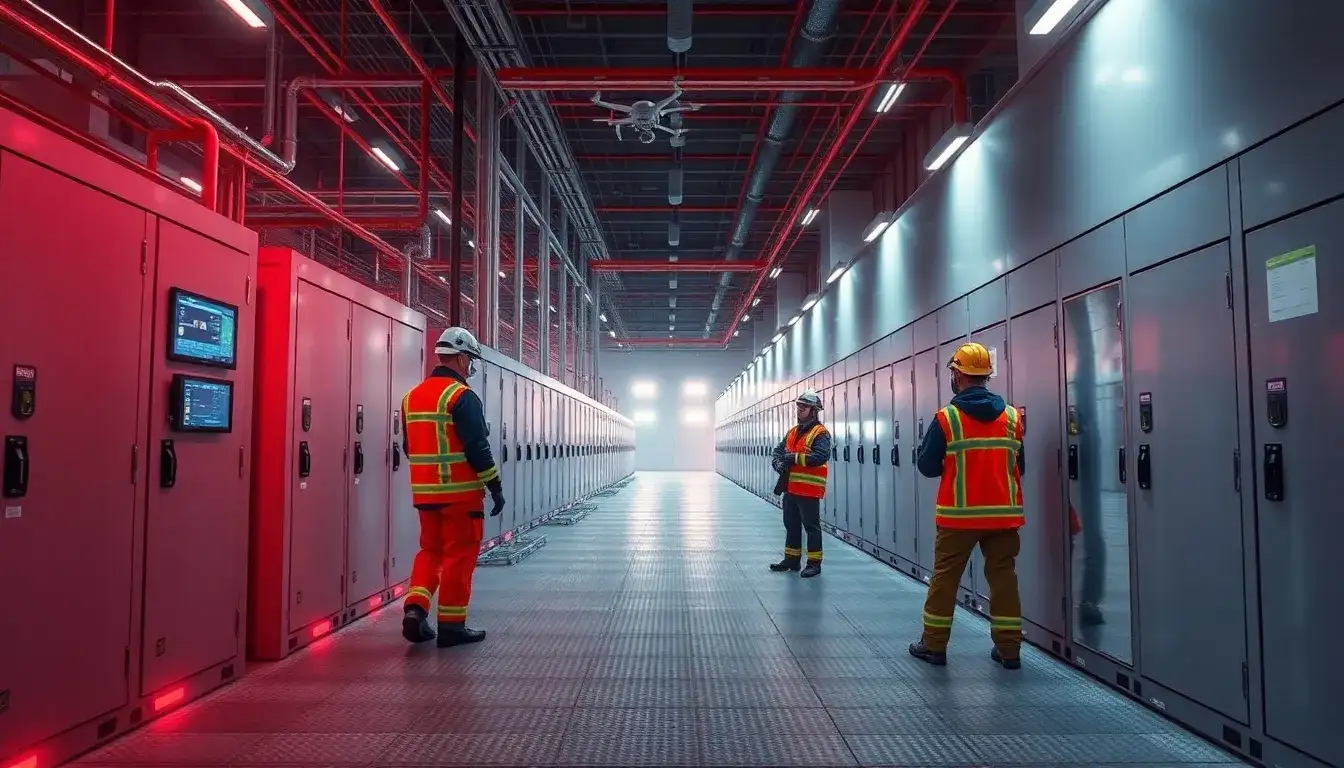Could New Battery Energy Storage Safety Technology Have Prevented the Moss Landing Fire?
Contributed by Matt Ward, President, EticaAG
The global shift towards renewable energy has led to an unprecedented demand for Battery Energy Storage Systems (BESS), which are essential for integrating renewable energy sources into the grid and ensuring stability and reliability. However, safety concerns, particularly the risk of fires caused by thermal runaway, present significant challenges. Notable incidents, such as the fire at the Moss Landing Energy Storage Facility, have highlighted the shortcomings of current cooling and safety measures.
Immersion cooling, patented for BESS by EticaAG (a partnership between Etica Battery and AGI), provides optimal thermal management and advanced fire suppression. This technology directly addresses the root causes of thermal runaway, significantly enhancing safety, reliability, and performance when compared to traditional methods. This article explores the technical details of immersion cooling and its effectiveness in reducing risks associated with BESS installations.
Understanding Thermal Runaway
Thermal runaway occurs when a battery cell generates heat faster than it can be dissipated, leading to a chain reaction of overheating and failure in neighboring cells. This process is typically initiated by external stressors such as physical damage, overcharging, or elevated temperatures, which accelerate internal chemical reactions uncontrollably. As these reactions progress, they produce heat, increasing chemical activity and creating a self-sustaining feedback loop that can ultimately result in fire or explosion. This poses a significant safety risk and undermines the reliability and operational efficiency of energy storage systems.
Limitations of Current Cooling and Fire Suppression Methods
Air cooling relies on the circulation of air to dissipate heat, but this method is often ineffective in densely packed systems where airflow is obstructed, leading to uneven temperature distribution and hotspots that can trigger thermal runaway. Liquid cold plate cooling, which employs conduits of liquid to absorb and transport heat away from the cells, provides better thermal management but is still inherently reactive, addressing heat only after it has been generated without offering preventive measures against the onset of thermal runaway. Fire suppression systems, while crucial, act solely in response to fires that have already started, focusing on containment rather than prevention. These limitations underscore the need for more proactive and comprehensive solutions to manage thermal risks in BESS.
Battery Immersion Technology: A New Solution for BESS Fire Safety
Immersion cooling involves submerging battery cells in a dielectric, non-flammable liquid. However, EticaAG’s patented cooling circulation system goes beyond simple submersion. Here’s how it functions:
The coolant absorbs heat directly from the battery cells and flows to a reservoir where it dissipates the heat. Pumps circulate the liquid, preventing thermal gradients that could compromise performance. An integrated battery management system (BMS) circulates the coolant throughout the system as needed.
Even in the unlikely event of a pump failure, the fire protection remains effective. The non-flammable liquid continuously surrounds the battery cells, preventing fire propagation regardless of circulation. The system’s core safety function—isolating cells from oxygen and external ignition sources—remains intact at all times. This liquid serves as an effective heat transfer medium, dissipating heat while isolating cells from ignition sources. By surrounding each cell with this specialized liquid, heat is transferred almost instantaneously, preventing temperature spikes that could lead to thermal runaway. Moreover, this method eliminates the need for active air circulation, making it a more efficient and compact thermal management solution.
Key Benefits of Immersion Cooling: Fire Suppression & Thermal Management
Unlike traditional air or cold plate cooling methods, immersion cooling submerges battery cells directly in a dielectric liquid, ensuring uniform temperature distribution and preventing localized hotspots that could trigger thermal runaway.
Immersion cooling mitigates the risk of thermal runaway through two key mechanisms:
- Oxygen Isolation: The dielectric liquid forms a physical barrier around each cell, preventing exposure to oxygen, a necessary element for combustion. In case of a cell failure, this isolation minimizes the risk of ignition, unlike air-cooled or cold plate systems that may vent gases, potentially fueling a fire.
- Heat Containment and Dissipation: If a battery cell experiences thermal runaway, the surrounding liquid quickly absorbs and dissipates the excess heat, preventing neighboring cells from reaching critical temperatures and effectively containing the failure to a single cell. In contrast, air-cooling or liquid cold plate methods depend on external cooling loops that may not react swiftly enough to avert fire propagation.
In tests, a lithium iron phosphate battery cell was heated to induce thermal runaway, and the immersion cooling system successfully suppressed the resulting flame, preventing fire spread or damage to adjacent cells.
Beyond fire suppression, immersion cooling also optimizes battery performance by maintaining a consistent and controlled temperature environment. Lithium-ion batteries degrade more quickly when exposed to high temperatures or fluctuations. Immersion cooling reduces thermal stress by:
- Minimizing temperature swings: The surrounding liquid stabilizes the battery’s temperature, preventing expansion and contraction of materials that can cause wear over time.
-
Reducing electrolyte decomposition: High temperatures accelerate the breakdown of electrolytes inside cells, contributing to capacity fading. By maintaining an optimal temperature range, immersion cooling slows degradation and extends battery lifespan.
-
Enhancing energy efficiency: Batteries operate more efficiently within their ideal thermal range. Stable temperatures lead to improved charge/discharge efficiency and reduced energy losses.
By addressing fire risks and thermal stability, immersion cooling enhances safety and extends the operational life of BESS deployments. This makes it an optimal solution for mission-critical applications such as data centers, grid-scale energy storage, and commercial and industrial backup power, where reliability is essential.
Could Immersion Cooling Have Prevented the Moss Landing Fire?
The Moss Landing incident, one of the largest BESS fires in recent history, was attributed to thermal runaway triggered by overheating. The failure of cooling systems and fire suppression measures allowed the situation to escalate, resulting in extensive damage and system downtime. Reports indicated that the conventional air and liquid cooling methods in place could not dissipate the excessive heat generated by the batteries, leading to cascading failures. The absence of a robust containment mechanism further exacerbated the situation as the fire spread rapidly across adjacent cells. Additionally, the facility’s fire suppression system struggled to extinguish the flames, highlighting the limitations of reactive measures in addressing thermal runaway events.
Immersion cooling could have fundamentally changed the outcome at Moss Landing by addressing the root causes of the fire. With its ability to provide direct and consistent heat dissipation, immersion cooling would have kept battery temperatures within safe operating limits, preventing the overheating that triggered thermal runaway. By submerging cells in a non-flammable, dielectric liquid, any thermal failure would have been contained immediately, stopping heat from spreading to adjacent cells and halting the cascade of failures before it began. Furthermore, the fire-retardant properties of the immersion cooling liquid would have eliminated flames from thermal runaway, even in the event of a cell failure. This proactive containment approach could have significantly reduced the scale of the incident, minimizing damage and ensuring system stability under high-load conditions.
The Path to Safer Energy Storage
Thermal runaway remains a critical challenge in deploying large-scale battery energy storage systems. Incidents like the Moss Landing fire emphasize the limitations of conventional cooling and safety measures. Immersion cooling presents a transformative solution, addressing the root causes of thermal runaway and significantly enhancing fire safety. To ensure the safe and reliable growth of renewable energy storage, the energy industry must adopt innovative technologies like immersion cooling. By prioritizing safety and long-term performance, we can build a more resilient and sustainable energy future.
About the Author
Matt Ward is the new president of EticaAG, dedicated to providing safe and reliable energy storage solutions to the utility, commercial & industrial, and residential markets. His career began as a civilian nuclear engineer in the U.S. Navy, supervising the maintenance of nuclear reactors on submarines, destroyers, and aircraft carriers. He later transitioned into construction and the oil and gas industry before joining a real estate development firm as part of the executive team. Ward founded Solmicrogrid to deliver safe and reliable power to small businesses, with Chick-fil-A as its first client. Morgan Stanley invested in the venture, leading to Ward’s successful tenure as CEO before exiting. Throughout his career, two principles have guided him: that challenges are often solvable, and the importance of perseverance and patience. These principles have contributed to his success in both personal and professional endeavors, and he carries them into every business venture.
Original article by NenPower, If reposted, please credit the source: https://nenpower.com/blog/advancements-in-battery-energy-storage-safety-technology-could-they-have-prevented-the-moss-landing-fire/



